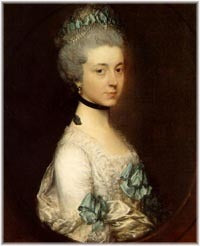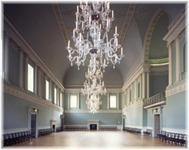Richard "Beau" Nash: The Original Beau
That the elder ladies and children be contented with a second bench at the ball, as being past or not come to perfection. --Rule VIII of Nash’s Rules by General Consent Determined
 Richard ‘Beau’ Nash was born in 1674 in Swansea, Wales. His father, also Richard, was a partner in a glass-making factory. I could find nothing about siblings so he may have been an only child. Little is known about the young Richard except that he was reputed to have ‘a natural vivacity’. At twelve he was sent to the Free Grammar School of Queen Elizabeth in Carnarthen 20 miles north of Swansea where he distinguished himself as an athlete, particularly it seems at both forward and backward standing jumps. From the Grammar School he went to Jesus College, Oxford, to read Law. He did not shine at his studies and was sent down some time later for becoming embroiled with too many women, probably of the wrong sort. With the financial backing of his father he then became an ensign in the Guards but soon found both the obligations of the Army and the lack of ready money a problem. He persuaded his father to let him revert to the study of Law, this time at the Inner Temple in London. Nash was a dandy from a young age, sporting a velvet coat, ruffles, diamond buckles and a diamond brooch, and soon became aware that he possessed a certain style and manner which attracted people to him. He was not well off but supplemented his income by gambling, at which he appears to have been extraordinarily successful. He was by now a well-known young man-about-town and was welcomed into society. Nash gradually lost interest in the Law and in 1705 decided to try his luck in Bath, which was just beginning to become popular as a health spa. He became acquainted with the then Master of Ceremonies, Captain Webster, and was soon appointed his assistant. Shortly afterwards the unfortunate Captain was killed in a sword-fighting duel and Nash, still in his early thirties, found himself elected by the Corporation of Bath as the new Master of Ceremonies. Because of the recent disaster Nash began his term by abolishing the wearing of swords and, ipso facto, the abandonment of duelling came about. He next insisted that all lodging houses, most of which were damp and dilapidated, must be renovated and he himself fixed a tariff for every room.
Richard ‘Beau’ Nash was born in 1674 in Swansea, Wales. His father, also Richard, was a partner in a glass-making factory. I could find nothing about siblings so he may have been an only child. Little is known about the young Richard except that he was reputed to have ‘a natural vivacity’. At twelve he was sent to the Free Grammar School of Queen Elizabeth in Carnarthen 20 miles north of Swansea where he distinguished himself as an athlete, particularly it seems at both forward and backward standing jumps. From the Grammar School he went to Jesus College, Oxford, to read Law. He did not shine at his studies and was sent down some time later for becoming embroiled with too many women, probably of the wrong sort. With the financial backing of his father he then became an ensign in the Guards but soon found both the obligations of the Army and the lack of ready money a problem. He persuaded his father to let him revert to the study of Law, this time at the Inner Temple in London. Nash was a dandy from a young age, sporting a velvet coat, ruffles, diamond buckles and a diamond brooch, and soon became aware that he possessed a certain style and manner which attracted people to him. He was not well off but supplemented his income by gambling, at which he appears to have been extraordinarily successful. He was by now a well-known young man-about-town and was welcomed into society. Nash gradually lost interest in the Law and in 1705 decided to try his luck in Bath, which was just beginning to become popular as a health spa. He became acquainted with the then Master of Ceremonies, Captain Webster, and was soon appointed his assistant. Shortly afterwards the unfortunate Captain was killed in a sword-fighting duel and Nash, still in his early thirties, found himself elected by the Corporation of Bath as the new Master of Ceremonies. Because of the recent disaster Nash began his term by abolishing the wearing of swords and, ipso facto, the abandonment of duelling came about. He next insisted that all lodging houses, most of which were damp and dilapidated, must be renovated and he himself fixed a tariff for every room.
In 1708 Nash arranged for an Assembly House to be built and levied a subscription on all visitors to Bath. As Maggie Lane told us, he forbade all private parties (what power!) but invited everyone to the Assembly House for dinners, teas, breakfast concerts and balls. On the orders of the resident doctor who was concerned for the health of those who had come ‘to take the waters’, and with the concurrence of Nash, all balls began at 6pm and finished precisely at eleven. A list of rules was drawn up and deportment at dances was strictly regulated. Nash even forbade ‘exhibitions of resentment from either gentlemen or ladies, (who displayed it) on the grounds that someone had danced out of turn.’ He ridiculed, and so made unfashionable, the wearing of boots in the Assembly House and let it be known that swearing was out of order. Most things in Bath seem to have cost a great deal of money, e.g. a crown for pen and paper to write a letter and up to a guinea to borrow books from the bookseller. Amazingly enough there was no revolt against either the restrictions or the charges and it is reported that guests were pleased to obey. Just prior to 1720 Nash arranged for a large ballroom to be added to the Assembly House. Later on he was involved in the encouragement and employment of architect John Wood who is famous for his wonderful Bath buildings. This was the beginning of the expansion of Bath as many more visitors, including artists and writers, members of the aristocracy and later royalty, started to arrive. It is of interest that Nash was famous enough to rate a mention in Henry Fielding’s Tom Jones in the chapter called ‘The History of Mrs Fitzpatrick’. His name can also be come across in Georgette Heyer’s novels.
During the period 1720 to the 1740s Beau Nash lead a busy life. As well as other duties he organised the recreations of the day, arranged for the ringing of bells to announce the arrival of distinguished guests to Bath, visited the new arrivals to pay his respects, arbitrated differences between neighbours or visitors and solicited subscriptions for his latest plan, a hospital. In 1735 he was also installed as Master of Ceremonies at Tunbridge Wells where he enforced similar rules to those at Bath. Nash was a prodigious gambler but went to a great deal of trouble to prevent others less experienced than he from losing all their money. He had long been a dandy and an arbiter of fashion, and it was said that his well-known white hat was awarded more respect than many a general. There is a lovely quote from Lord Chesterfield describing the Beau at a ball:
He wore his gold-laced clothes on the occasion, and looked so fine that, standing by chance in the middle of the dancers, he was taken by many at a distance for a gilt garland.
Although an earlier law against gambling had been enacted, Nash and his fellow players, male and female, had managed to get around this by various means including the invention of new games. However in 1745 the anti-gambling law was tightened. Although the popularity of Bath continued this was a great drawback to Nash, not only because of being a successful gambler on his own account, but because he had awarded himself as Master of Ceremonies a percentage of all winnings. From this time on his fortunes and his influence gradually declined. He had been the epitome of the benevolent dictator, an imperious rule-maker who nevertheless showed great generosity to those who had come across hard times. He now found himself in the same predicament, and had to sell most of his possessions to survive.
He died in straitened circumstances in 1762, aged 87. Beau Nash never married but had a relationship of many years standing with one Fanny Murray. After she left him he took up with Juliana Papjoy who was his companion and who cared for him until his death. The name of Richard ‘Beau’ Nash is intricately entwined with that of Bath and it could be said that the city itself is his monument. It seems to me that here was a man who was able to use his talents in a way that suited him and who more than many of us, truly found his niche in life.
This article, wriiten by Halcyon Evans, was copied by permission of The Jane Austen Society of Australia. It first appeared in their December 2000 newsletter. To learn more about this organization, visit their website: http://www.jasa.net.au/. Notes taken from Beau Nash: Monarch of Bath and Tunbridge Wells, by Willard Connely; 1955.



1 comment
[…] Halcyon Evans: Richard “Beau” Nash: The Original Beau […]
Façades and derrières - Curiosity & Collectanea
Leave a comment
This site is protected by hCaptcha and the hCaptcha Privacy Policy and Terms of Service apply.